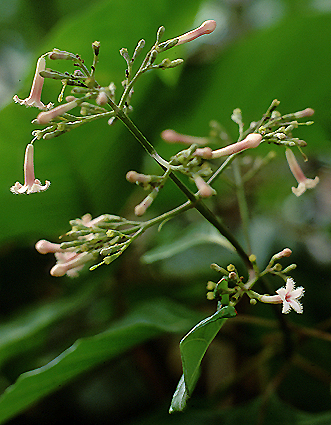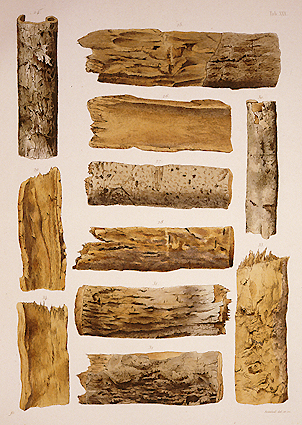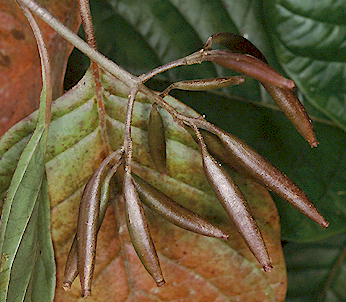Rubiaceae of the New World
By Piero Delprete and
Rocio Cortés
CINCHONA Linnaeus
Rubiaceae of the New World
By Piero Delprete and
Rocio Cortés
CINCHONA Linnaeus
 |
 |
 |
Inflorescence of Cinchona pubescens (upper left)
Province of Carchi, Ecuador Photo P. Delprete Bark samples (quinine bark) of various species of Cinchona
Fruits of Cinchona succirubra (lower left).
|
Synonyms: Chinchona Weddell; Cinchona sect. Quinquina Endlicher; Kinkina Adanson; Quinquina la Condamine ex O. Kuntze (orth. var.)
Shrubs or small, medium-sized to tall canopy trees; raphides absent; axillary thorns absent. Stipules interpetiolar, free at base or interpetiolar, connate at base, broadly triangular, obovate, oblong or ligulate, subcaducous or readily caducous. Leaves opposite, long- to short-petiolate; blades ovate, elliptic, obovate, broadly obovate, oblong, orbicular, chartaceous, stiffly chartaceous, papyraceous, thinly to thickly coriaceous; foliar pellucid glands absent; domatia sparse tufts or dense tufts of hair or absent. Inflorescence terminal, frondose or not frondose, paniculate, densely or sparsely branched. Flowers bisexual, protandrous. Calyx cup-shaped, with small lobes, campanulate or short tubular, persistent; lobes 4 to 6, deltoid or narrowly to broadly triangular, oblong, elliptic or ovate, minute or small, or absent. Calycophylls absent. Corolla hypocrateriform, actinomorphic, white to cream-white, pinkish-white, reddish-white, pink, red, violet to purple; tube externally minutely puberulent, puberulent, pubescent or hirtellous, internally puberulent, pubescent or hirtellous, without a pubescent ring inside; orifice annular thickening absent; lobes 4 to 6, valvate, narrowly triangular, lanceolate, linear-lanceolate, margin entire, acute at apex. Stamens alternate to the corolla lobes, included or partially exserted (only tips exserted); anthers narrowly elliptic, elongate or linear, round at base, round at apex, dehiscing by longitudinal slits, dorsifixed near the base; filaments attached at the lower part of the corolla tube, free at base, slender, long, shorter than corolla tube, equal, glabrous. Pollen colporate, apertures 3, exine surface foveolate or perforate, released as monads. Style exserted just beyond the corolla or included, terete throughout, not fleshy, glabrous; lobes 2, ovate, elliptic or oblong. Ovary inferior, 2-locular, obconical, narrowly obconical or ovoid; placentation axile, placenta peltate to the entire lenght of the septum, ovules many per locule. Fruit a septicidal capsule, dehiscing acropetally (rarely basipetally), thinly woody. Seeds ascendingly imbricate, laterally compressed; wings bipolar, margin nearly entire, dentate or fimbriate.
Geographic distribution: Northern Central America (up to southern Mexico), southern Central America, northern Chocó area, southern Chocó area, West Indies, Magdalena-Llanos area, Napo-Marañón drainage, southwestern Amazon Basin, western Amazon Basin, central Amazon basin, Brazilian Atlantic coast, Brazilian planalto, northern Andes (above 1000 m), central Andes and southern intertropical Andes. Plantations of several species of Cinchona are still present throughout the Andes. Cinchona succirubra was introduced by man in the Galapagos Islands, and has become an agressive invasor of the natural vegetation of these islands.
Number of species: 23.
References: L. Andersson, A revision of the genus Cinchona
(Rubiaceae-Cinchoneae).
Mem. New York Bot. Gard. 80: 1–75. 1998.